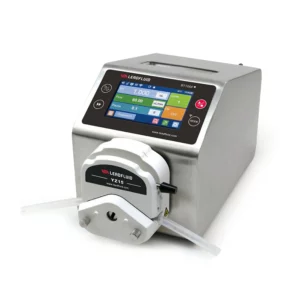A peristaltic metering pump works based on the principle of peristalsis, which involves the compression and relaxation of a flexible tube or hose to move fluids.
Here’s a step-by-step explanation of how a peristaltic metering pump operates:
- Tube or Hose Selection: A flexible tube or hose is selected based on the specific fluid being pumped and the required flow rate. The tube material is chosen to be compatible with the fluid’s properties, such as its chemical composition, temperature, and viscosity.
- Pump Head Design: The pump head of a peristaltic metering pump typically consists of a rotor or roller mechanism and a track or housing. The rotor or roller has several lobes or shoes that are evenly spaced around its circumference.
- Tube Installation: The selected tube is positioned within the pump head, forming a complete loop. The tube is properly seated against the track or housing, ensuring a secure fit.
- Compression and Fluid Displacement: As the pump is activated, the rotor or roller mechanism starts rotating. As each lobe or shoe passes over the tube, it applies pressure and compresses the tube against the track or housing. This compression creates a sealed section or occlusion in the tube, isolating the fluid.
- Fluid Propulsion: As the rotor or roller continues to rotate, the compressed section of the tube moves along the track or housing, effectively displacing the fluid within the tube. The occlusion progresses along the tube, pushing the fluid forward in a pulsating or continuous manner, depending on the pump design.
- Tube Relaxation and Refilling: Once the occlusion reaches the end of the pump head, the tube is released from compression, allowing it to regain its original shape. This relaxation phase creates a suction effect that draws more fluid into the tube, refilling it for the next cycle.
- Flow Rate Control: The flow rate of the peristaltic metering pump can be adjusted by varying the rotational speed of the rotor or roller mechanism. Changing the speed alters the frequency and rate at which the occlusions travel along the tube, thereby controlling the volume of fluid being dispensed.
- Accuracy and Precision: Peristaltic metering pumps are known for their precise and accurate fluid delivery. The pump’s flow rate can be calibrated and controlled to meet specific dosing requirements, making them suitable for applications that demand precise and consistent fluid metering.
Overall, the peristaltic metering pump’s operation relies on the cyclic compression peristaltic metering pump and relaxation of a flexible tube to move fluids in a controlled and measured manner. This design offers advantages such as gentle fluid handling, easy maintenance, and the ability to handle a wide range of fluids and viscosities.
What is the peristaltic metering pump used for ?
Peristaltic metering pumps are widely used in various industries and applications that require accurate and controlled fluid metering. Some common applications of peristaltic metering pumps include:
- Chemical Dosing: Peristaltic metering pumps are commonly used for precise and controlled dosing of chemicals in industrial processes. They are employed in water treatment plants, wastewater treatment facilities, and chemical manufacturing industries to add chemicals such as disinfectants, pH adjusters, coagulants, and flocculants.
- Pharmaceutical and Biotechnology: Peristaltic metering pumps are utilized in pharmaceutical and biotechnology applications that require accurate and sterile fluid delivery. They are used for dosing medications, nutrients, buffers, and culture media in drug manufacturing, research laboratories, and bioprocessing.
- Food and Beverage: Peristaltic metering pumps find application in the food and beverage industry for precise dosing and dispensing of ingredients, additives, flavors, and colors. They are used in processes such as flavoring, beverage production, liquid filling, and dosing of food additives.
- Laboratory and Scientific Research: Peristaltic metering pumps are commonly used in laboratories and scientific research settings for accurate and controlled fluid delivery. They are employed in analytical instruments, chromatography systems, sampling devices, and other applications that require precise metering of liquids.
- Medical and Healthcare: Peristaltic metering pumps are used in medical and healthcare environments for various applications, including drug infusion, dialysis, blood sampling, and patient monitoring. They offer precise control over the delivery of medications and fluids, ensuring accurate dosing and patient safety.
- Environmental Monitoring: Peristaltic metering pumps are utilized in environmental monitoring and sampling applications. They are used for water sampling, groundwater remediation, environmental analysis, and other processes that require the accurate metering of sampling solutions and reagents.
- Industrial Processes: Peristaltic metering pumps find application in a wide range of industrial processes, including chemical processing, oil and gas, mining, and pulp and paper industries. They are used for dosing chemicals, slurries, reagents, and abrasive fluids with high viscosity or containing solid particles.
The versatility, accuracy, and sterile fluid handling capabilities of peristaltic metering pumps make them suitable for a diverse range of applications. They are preferred in industries that require precise control, gentle fluid handling, and the ability to handle a wide range of fluids, including corrosive, viscous, or sensitive materials.
